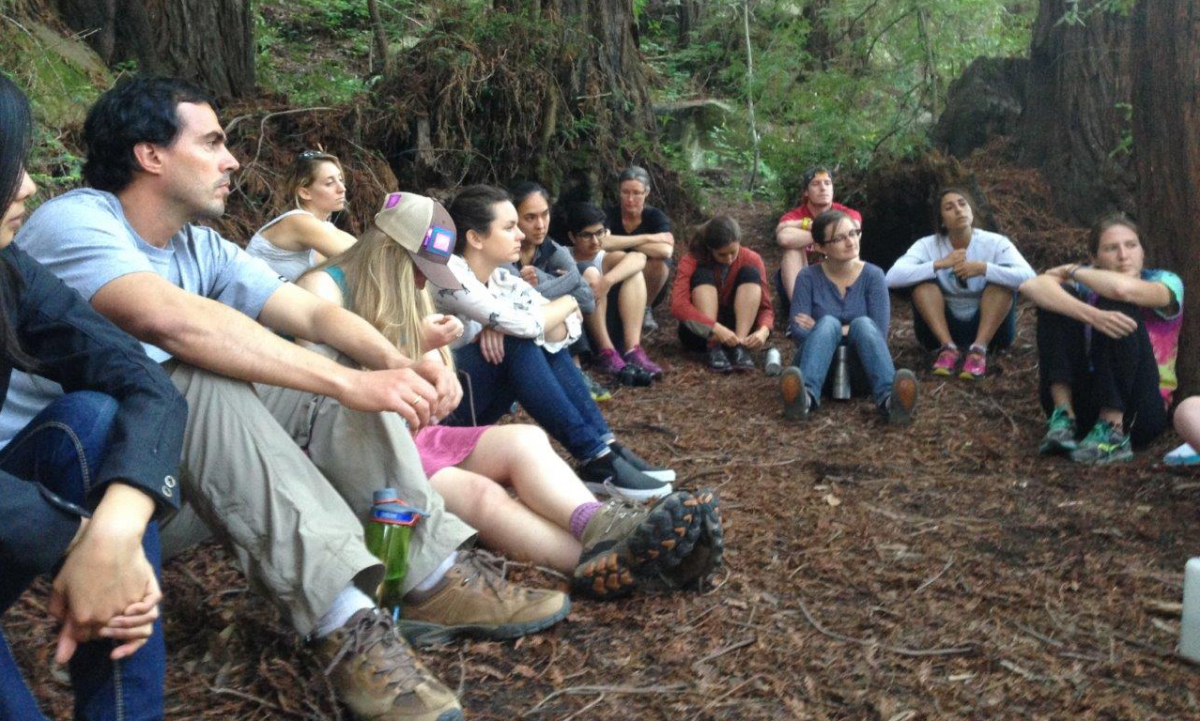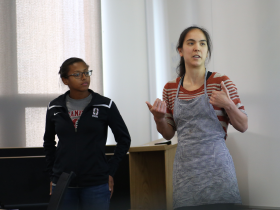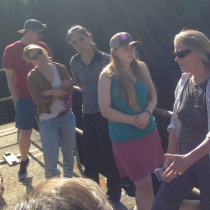Students as a Link Between the Community and Environment

Students as a Link Between the Community and Environment
Instructors: Nicole Ardoin
Department: Graduate School of Education
Course: EDUC 332 – Theory and Practice of Environmental Education
Audience: undergraduates and graduate students
Format: 3 hours once per week that included discussion, collaborative works, and place-based learning
Learning Goals
In examining the history, theoretical foundations, and practice of environmental education, this course aims to empower students with a deep understanding of environmental education, as well as its relationship to environmental issues. In the class, students explore the theoretical foundations of both learning and  environmental behavior that shape environmental education. They examine various examples of environmental education, ranging from informal to formal in context. Students also acquire the skills necessary to apply evaluation strategies to environmental education programs.
environmental behavior that shape environmental education. They examine various examples of environmental education, ranging from informal to formal in context. Students also acquire the skills necessary to apply evaluation strategies to environmental education programs.
One overarching goal of the course is for students to gain first-hand experience with various forms of environmental education through collaborative projects with community partners. Students experience environmental education in real-world contexts and have the opportunity to contribute to actual environmental education programs in meaningful ways. Through active collaboration with community partners, students develop deeper understandings of the roles and needs of actual environmental education programs.
Approach
Each 3-hour weekly class session offers a diverse collection of ways to engage with ideas about environmental education in a variety of settings. Far from feeling like a traditional classroom, this class maximizes Stanford’s outdoor space and unique learning opportunities. Daily class activities range from whole class discussion in a sunny courtyard to small group work in campus’ many wooded groves. “With the course content focused on the environment, I believe it’s essential that we get outside as much as possible; and with so many interesting outdoor teaching spaces on campus, I try to take advantage of those in creative ways,” says Professor Ardoin. Snacks are always involved, and student collaboration is an essential piece to each class meeting.
 Emphasizing design thinking in groups, this class also takes advantage of Stanford’s d.school. Several class meetings are held in the d.school, where students are introduced to innovative ways of finding solutions to problems. They engage with principles of design thinking, practice active collaboration, and learn to communicate environmental education messages through storytelling. Sticky notes, whiteboard sketches, and enthusiastic conversation are all hallmarks of these sessions. “I find that design thinking frees up the students’ creativity, encouraging them to think in interesting, new—and potentially most important—collaborative ways,” explains Professor Ardoin.
Emphasizing design thinking in groups, this class also takes advantage of Stanford’s d.school. Several class meetings are held in the d.school, where students are introduced to innovative ways of finding solutions to problems. They engage with principles of design thinking, practice active collaboration, and learn to communicate environmental education messages through storytelling. Sticky notes, whiteboard sketches, and enthusiastic conversation are all hallmarks of these sessions. “I find that design thinking frees up the students’ creativity, encouraging them to think in interesting, new—and potentially most important—collaborative ways,” explains Professor Ardoin.
Additionally, students have the opportunity to explore Stanford’s Jasper Ridge biological preserve. One class session meets for the entire 3 hours at the preserve, where students are introduced to the environmental education efforts that take place there, as well as to the ecologically rich, undeveloped piece of land.
In-Class Learning Opportunities
In-class learning in EDUC 332 maximizes opportunities to learn from both peers and experts. Often, class opens with a full-class discussion of assigned readings, usually seminal pieces of peer-reviewed literature in the field of environmental education. As students in this class tend to hail from different academic and life experience backgrounds, discussion is typically lively, and uses the readings as a platform to explore a wide variety of ideas.
Learning in small groups is also a key element of class. Typically, students will work in small groups for a significant portion of class. Sometimes, this small group work focuses on diving deeper into readings or  drawing connections between readings and life experiences. Other times, small group work focuses on in-class tasks related to exploring the ideas at hand.
drawing connections between readings and life experiences. Other times, small group work focuses on in-class tasks related to exploring the ideas at hand.
This past spring, one popular class activity involved seeking out various environmental learning opportunities on campus. Students were assigned to explore campus, identify learning opportunities, and analyze how these opportunities could be turned into legitimate pieces of environmental education.
Early in the quarter, students, in groups, have the opportunity to select a community partner with whom they will work to develop a project over the course of the quarter. This project, a key feature of EDUC 332, ends up being the focus of much classwork, especially toward the end of the quarter. In teams, students use some of the weekly in-class time to plan projects, refine ideas, and work on deliverables to their community partners.
Out of Class Strategies
The community partnership project, a foundational element of this class, offers students the unique experience of working directly with an environmental education focused organization. Working in conjunction with one organization over the course of the 10-week quarter, each student team devises a self-directed project, based on the needs of their respective partner organizations. “The community-based project,” Professor Ardoin emphasizes, “is a critical way for the students to put into practice what they’re learning in the class. They can take what they read, what we discuss, and apply it in a real-world setting with inspiring community partners in the Bay Area and beyond.”
 Prior to the quarter, Professor Ardoin identifies several community partner organizations. While partners vary year-to-year, many organizations work with EDUC 332 students several years in a row. Given the strong reputation of the class and Professor Ardoin’s professional relationships, organizations are often eager to partner with Stanford students. Partners have ranged from NatureBridge, a residential environmental education program located in national parks, including Yosemite and Golden Gate; to the Marine Science Institute, a Redwood City-based organization dedicated to connecting children and families to environmental issues in the San Francisco Bay; to the North American Association for Environmental Education, based in Washington, DC. Particularly memorable projects have included implementing a research study focused on whale watching with the Oceanic Society, designing curriculum for school gardens at Ohlone and Nixon Elementary Schools, and analyzing environmental learning opportunities at local farmer’s markets. “Each quarter, the students can choose from a range of community partners to craft a project that reflects their interests and experience—from working with youth to community members, or from working on a research project to developing curriculum.”
Prior to the quarter, Professor Ardoin identifies several community partner organizations. While partners vary year-to-year, many organizations work with EDUC 332 students several years in a row. Given the strong reputation of the class and Professor Ardoin’s professional relationships, organizations are often eager to partner with Stanford students. Partners have ranged from NatureBridge, a residential environmental education program located in national parks, including Yosemite and Golden Gate; to the Marine Science Institute, a Redwood City-based organization dedicated to connecting children and families to environmental issues in the San Francisco Bay; to the North American Association for Environmental Education, based in Washington, DC. Particularly memorable projects have included implementing a research study focused on whale watching with the Oceanic Society, designing curriculum for school gardens at Ohlone and Nixon Elementary Schools, and analyzing environmental learning opportunities at local farmer’s markets. “Each quarter, the students can choose from a range of community partners to craft a project that reflects their interests and experience—from working with youth to community members, or from working on a research project to developing curriculum.”
Student groups meet and interact with their community partners on a regular basis outside of class to develop meaningful, relevant ways of contributing to organizations. Students have found the community partnership experience to be truly valuable. The work effectively connects students to local communities, while also supporting real environmental education in action. Students learn firsthand about implementing and evaluating educational programs as they immerse themselves in authentic, meaningful work. In many cases in the past, community partner projects have led students to various opportunities beyond Stanford, including internships and employment.




